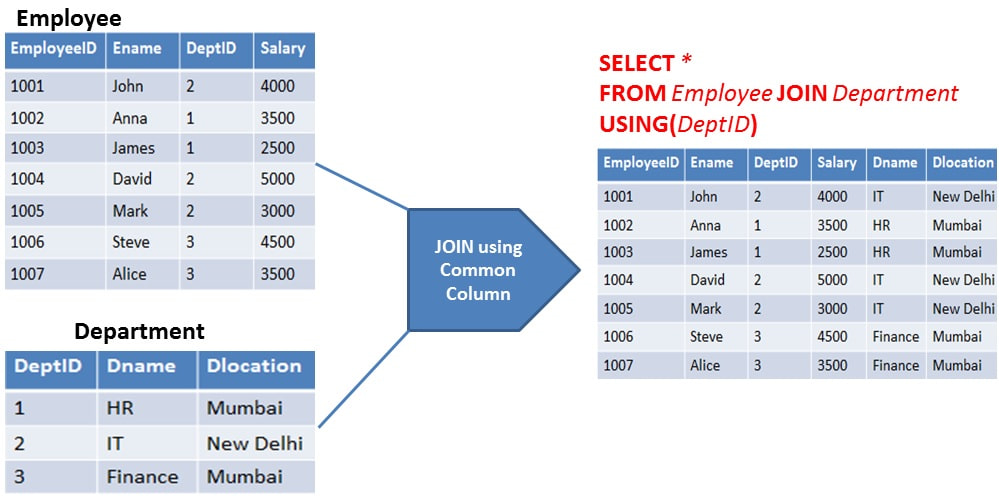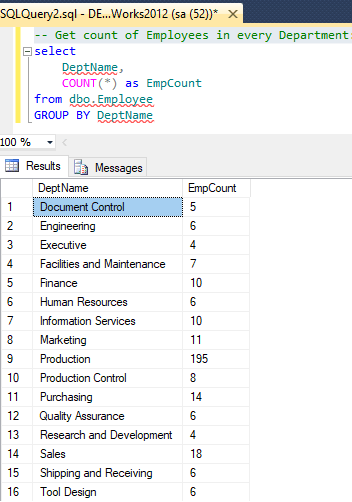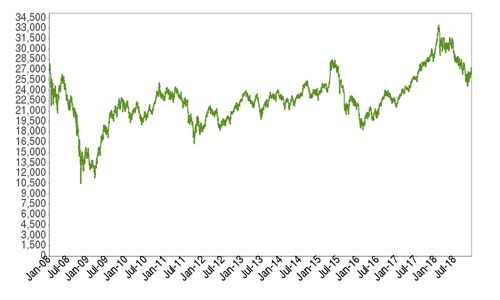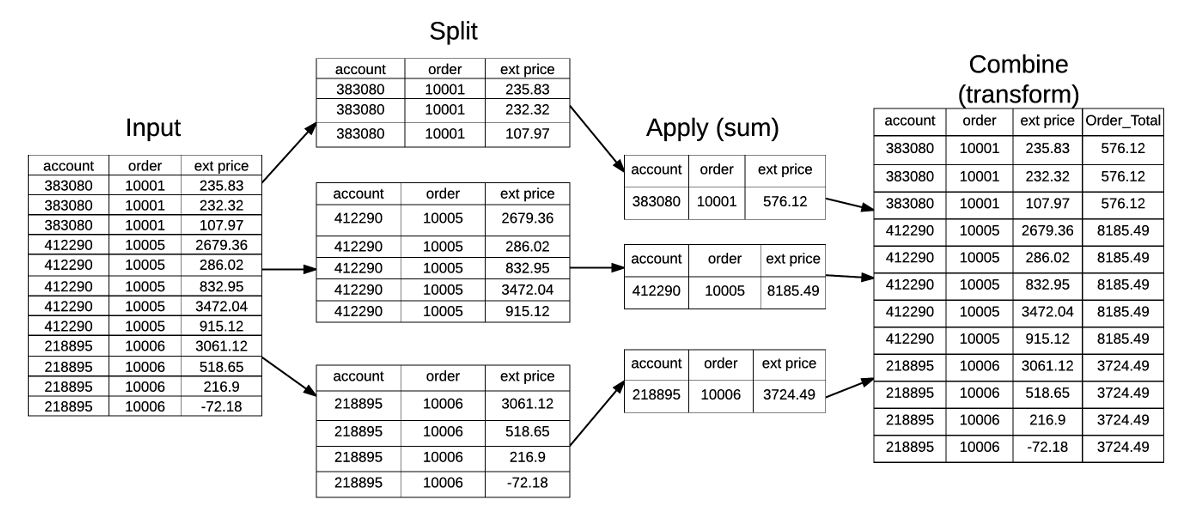Aggregate functions return a single result row based on groups of rows, rather than on single rows. Aggregate functions can appear in select lists and in ORDER BY and HAVING clauses. They are commonly used with the GROUP BY clause in a SELECT statement, where Oracle Database divides the rows of a queried table or view into groups. In a query containing a GROUP BY clause, the elements of the select list can be aggregate functions, GROUP BY expressions, constants, or expressions involving one of these. Oracle applies the aggregate functions to each group of rows and returns a single result row for each group.
The COUNT function returns the total number of values in the specified field. All aggregate functions by default exclude nulls values before working on the data. Expression_n Expressions that are not encapsulated within an aggregate function and must be included in the GROUP BY Clause at the end of the SQL statement.
Aggregate_function This is an aggregate function such as the SUM, COUNT, MIN, MAX, or AVG functions. Aggregate_expression This is the column or expression that the aggregate_function will be used on. Tables The tables that you wish to retrieve records from.
There must be at least one table listed in the FROM clause. These are conditions that must be met for the records to be selected. The expression used to sort the records in the result set. If more than one expression is provided, the values should be comma separated.
ASC sorts the result set in ascending order by expression. This is the default behavior, if no modifier is provider. DESC sorts the result set in descending order by expression. If you omit the GROUP BY clause, then Oracle applies aggregate functions in the select list to all the rows in the queried table or view. However, aggregate functions take the values of a column from a group of rows and return the result as a single value.
Window functions take the values of a column from a group of rows and return a value for each row. An aggregate function can be specified in a window function. A window function cannot be specified in an aggregate function. SUM can be used as either an aggregate function or a window function.
The GROUP BY statement groups rows that have the same values into summary rows, like "find the number of customers in each country". The GROUP BY statement is often used with aggregate functions ( COUNT() , MAX() , MIN() , SUM() , AVG() ) to group the result-set by one or more columns. Including the GROUP BY clause limits the window of data processed by the aggregate function. This way we get an aggregated value for each distinct combination of values present in the columns listed in the GROUP BY clause. The number of rows we expect can be calculated by multiplying the number of distinct values of each column listed in the GROUP BY clause.
In this case, if the rows were loaded randomly we would expect the number of distinct values for the first three columns in the table to be 2, 5 and 10 respectively. So using the fact_1_id column in the GROUP BY clause should give us 2 rows. Let's start be reminding ourselves how the GROUP BY clause works. An aggregate function takes multiple rows of data returned by a query and aggregates them into a single result row.
Table 9.53 shows aggregate functions typically used in statistical analysis. In all cases, null is returned if the computation is meaningless, for example when N is zero. The BIT_AND(), BIT_OR(), and BIT_XOR() aggregate functions perform bit operations. Prior to MySQL 8.0, bit functions and operators required BIGINT (64-bit integer) arguments and returned BIGINT values, so they had a maximum range of 64 bits. Non-BIGINT arguments were converted to BIGINT prior to performing the operation and truncation could occur.
SQL Inner Join permits us to use Group by clause along with aggregate functions to group the result set by one or more columns. Group by works conventionally with Inner Join on the final result returned after joining two or more tables. You can also use the having clause with the Transact-SQL extension that allows you to omit the group by clause from a query that includes an aggregate in its select list. These scalar aggregate functions calculate values for the table as a single group, not for groups within the table. Spark also supports advanced aggregations to do multiple aggregations for the same input record set via GROUPING SETS, CUBE, ROLLUP clauses. The grouping expressions and advanced aggregations can be mixed in the GROUP BY clause and nested in a GROUPING SETS clause.
See more details in the Mixed/Nested Grouping Analytics section. When a FILTER clause is attached to an aggregate function, only the matching rows are passed to that function. Aggregate functions perform a calculation on a set of values and return a single value. Analytic functions compute an aggregate value based on a set of values, and, unlike aggregate functions, can return multiple rows for each set of values. Throughout this documentation, we refer to queries that contain aggregate functions as aggregate queries, and queries that contain analytic functions as analytic queries.
Can Aggregate Functions Be Used Without Group By ROLLUP is an extension of the GROUP BY clause that creates a group for each of the column expressions. Additionally, it "rolls up" those results in subtotals followed by a grand total. Under the hood, the ROLLUP function moves from right to left decreasing the number of column expressions that it creates groups and aggregations on. Since the column order affects the ROLLUP output, it can also affect the number of rows returned in the result set. We commonly use the aggregate functions together with the GROUP BY clause.
The GROUP BY clause divides the rows into groups and an aggregate function calculates and returns a single result for each group. How do you create the set of records for the aggregate functions? However, you can also use the full result set of the query as a single record set. Oracle Aggregate function is a type of function which operates on specified column and returns a single row result.
It is not permissible to include column names in a SELECT clause that are not referenced in the GROUP BY clause. The only column names that can be displayed, along with aggregate functions, must be listed in the GROUP BY clause. Since ENAME is not included in the GROUP BYclause, an error message results. DISTINCT and UNIQUE, which are synonymous, cause an aggregate function to consider only distinct values of the argument expression. The syntax diagrams for aggregate functions in this chapter use the keyword DISTINCT for simplicity. The GROUP BY clause is a SQL command that is used to group rows that have the same values.
Optionally it is used in conjunction with aggregate functions to produce summary reports from the database. If you use an aggregate function with any other function in a query, one field in the query must contain the GROUP BY function. In this case, the query will return one row for each equipment type in the facility, with the total maintenance cost for each type. This particular statement is slightly different from the other aggregate functions since there isn't a column supplied to the count function. This statement will return the number of rows in the employees table.
Another extension, or sub-clause, of the GROUP BY clause is the CUBE. The CUBE generates multiple grouping sets on your specified columns and aggregates them. In short, it creates unique groups for all possible combinations of the columns you specify. For example, if you use GROUP BY CUBE on of your table, SQL returns groups for all unique values , , and . The SUM() function returns the total value of all non-null values in a specified column. Since this is a mathematical process, it cannot be used on string values such as the CHAR, VARCHAR, and NVARCHAR data types.
When used with a GROUP BY clause, the SUM() function will return the total for each category in the specified table. The STDDEV() and STDDEVP() functions calculate sample standard deviation and population standard deviation respectively. The VAR() and VARP() functions calculate the sample variance and population variance respectively.
An easy way to remember what these four do, is to remember that the DEVnamed functions provide deviation statistics, while the VARnamed functions provide the variance statistics. You can read more about these four aggregate functions onMicrosoft Docs. MySQL AVG function returns the average of the values in a specified column. Just like the SUM function, it works only on numeric data types. The above example, returns error because there is a non-group functional column is used with an aggregate function MAX. So the SELECT statement returns all rows for Deptnumber column but aggregate function returns only one row.
The aggregate functions do not include rows that have null values in the columns involved in the calculations; that is, nulls are not handled as if they were zero. For each of these hypothetical-set aggregates, the list of direct arguments given in args must match the number and types of the aggregated arguments given in sorted_args. Unlike most built-in aggregates, these aggregates are not strict, that is they do not drop input rows containing nulls. Null values sort according to the rule specified in the ORDER BY clause.
The following table provides a list of the aggregate functions that you can use in queries. The Oracle Function column contains the function you will need to use if you are using an Oracle schema. The SQL Server Function column contains the function you will need to use if you are using a SQL Server database. Selecting a link in the table will open the appropriate example drop-down within this topic. If you want to run a query using only aggregate functions, the query will return one row with a column for each field. If you want to run a query using an aggregate function in conjunction with the GROUP BY function, the query will return one row for each value found in the grouped field.
Contrary to what most books and classes teach you, there are actually 9 aggregate functions, all of which can be used with a GROUP BY clause in your code. As we have seen in the samples above, you can have a GROUP BY clause without an aggregate function as well. As we demonstrated earlier in this article, the GROUP BY clause can group string values also, so it doesn't always have to be a numeric or date value.
Clause is omitted, aggregate functions are applying to all target row set of the query, i.e. we shall receive a single row as a result if the target set is not empty. An aggregation is the result returned from running an aggregate function in a query and is displayed in a new column in the results table. An aggregate function is a function that results of a set of the data queried being condensed into an aggregation. However, you can use the GROUP BY clause with CUBE, GROUPING SETS, and ROLLUP to return summary values for each group.
The COUNT() and REGR_COUNT() functions never return null, but either a number or zero . Other aggregate functions return NULL if the input data set contains NULL or has no rows. If you use aggregate functions without a GROUP BY clause, then the aggregate functions apply to all rows of the queried tables or views. It is therefore possible that another user may be performing a transaction that modifies the data while an aggregate calculation is in process.
An aggregate function performs a calculation on a set of values and returns a single value. These are often used with the GROUP BY clause of the SELECT statement. Like most things in SQL/T-SQL, you can always pull your data from multiple tables.
Performing this task while including a GROUP BY clause is no different than any other SELECT statement with a GROUP BY clause. The fact that you're pulling the data from two or more tables has no bearing on how this works. In the sample below, we will be working in the AdventureWorks2014 once again as we join the "Person.Address" table with the "Person.BusinessEntityAddress" table. I have also restricted the sample code to return only the top 10 results for clarity sake in the result set. In the first SELECT statement, we will not do a GROUP BY, but instead, we will simply use the ORDER BY clause to make our results more readable sorted as either ASC or DESC.
IIt is important to note that using a GROUP BY clause is ineffective if there are no duplicates in the column you are grouping by. A better example would be to group by the "Title" column of that table. The SELECT clause below will return the six unique title types as well as a count of how many times each one is found in the table within the "Title" column. SQL allows the user to store more than 30 types of data in as many columns as required, so sometimes, it becomes difficult to find similar data in these columns.
Group By in SQL helps us club together identical rows present in the columns of a table. This is an essential statement in SQL as it provides us with a neat dataset by letting us summarize important data like sales, cost, and salary. The GROUP BY statement is often used with aggregate functions (COUNT(),MAX(),MIN(), SUM(),AVG()) to group the result-set by one or more columns. The QUALIFY clause simplifies queries that require filtering on the result of window functions. The example below uses the ROW_NUMBER() function to return only the first row in each partition.
QUALIFY does with window functions what HAVING does with aggregate functions and GROUP BY clauses. Use the GROUP BY clause with aggregate functions in a SELECT statement to collect data across multiple records. It should be noted that except for count, these functions return a null value when no rows are selected. In particular, sum of no rows returns null, not zero as one might expect, and array_agg returns null rather than an empty array when there are no input rows.
The coalesce function can be used to substitute zero or an empty array for null when necessary. The GROUP BY clause divides the rows returned from the SELECTstatement into groups. For each group, you can apply an aggregate function e.g.,SUM() to calculate the sum of items or COUNT()to get the number of items in the groups.
Oracle aggregate functions calculate on a group of rows and return a single value for each group. Aggregate functions don't accept nested aggregate functions or window functions as arguments. Aggregate functions in SQL work on a set of records, producing a result for each set of records they process. An aggregate function is a function that summarizes the rows of a group into a single value. We'll call columns/expressions that are in SELECT without being in an aggregate function, nor in GROUP BY,barecolumns. In other words, if our results include a column that we're not grouping by and we're also not performing any kind of aggregation or calculation on it, that's a bare column.





























No comments:
Post a Comment
Note: Only a member of this blog may post a comment.